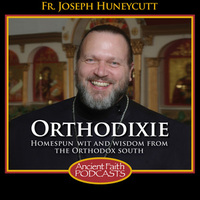![]() The Church’s view of human nature is: God created Man in His image and likeness to be in communion with Him. Man has free will to respond to this relationship. Although created in the image and after the likeness of God, humanity does not sustain communion with God (p.15). While humanity is still a creature, fashioned after God’s image, the likeness has been lost and, through sin, the image tarnished.
The Church’s view of human nature is: God created Man in His image and likeness to be in communion with Him. Man has free will to respond to this relationship. Although created in the image and after the likeness of God, humanity does not sustain communion with God (p.15). While humanity is still a creature, fashioned after God’s image, the likeness has been lost and, through sin, the image tarnished.
What is this “image?” St Gregory Palamas claims the “image” resides in man’s intellect. “For that which is in the image resides not in the body but in the intellect, which is the highest aspect of human nature. If there was something else still higher, that which is in the image would reside in that” (p.17).
One of the “truths” of Orthodoxy that has meant a great deal to me is the Fathers’ understanding of the parable of the Prodigal Son. Here I speak specifically of the understanding of what it means to say that he “came to himself” (Luke 15:17a). Georgios Mantzaridis writes:
Developing the parable of the prodigal son, and speaking of the dissipation of the father’s fortune by the younger son, Palamas gives the following allegorical interpretation: man’s chief wealth is his inborn intellect. While he keeps to the path of salvation, he keeps his intellect concentrated in itself and on the first and highest Intellect, God. If, however, he is led astray into misuse, then his intellect is dispersed and adheres to earthly things, and to the pleasures of the flesh. Man is required to fight against this pathological deviation through his return to himself and elevation towards God (p.82).
I have found this to be a valuable tool during periods of personal discernment. For, as Mantzaridis states, “If there exists something that man can and must seek and find within himself, it is not the self which deviated but the new man in Christ, born through baptismal grace and the other church sacraments” (p.83).
Thus, we do not come to our base nature which is corrupted by sin. Rather, we come to that which is good, beautiful and true. We come to that which Adam was before the Fall — we come to Christ, Who is within us.
We are called to “put on Christ.” We are to become like God — thereby regaining the “likeness” that we have lost by transgression. The first step in this process is the we “come to ourselves.” This coming to oneself is the first step toward repentance and reconciliation that leads to communion with God and neighbor. This is true when “man, ‘having entered wholly within himself’, becomes aware of himself and awaits within himself the coming of God and the divine transformation” (p.85).
Over the years, I’ve become aware of these moments of “coming to self” in my own life and ministry. It is an enlightening moment. It is a sober moment. It is a “reality” moment. Most often, it is a sudden moment — one which was seemingly long in coming.
This reflection, and page numbers referenced, is based on Georgios Mantzaridis’s book, The Deification of Man: St Gregory Palamas and the Orthodox Tradition.
Originally posted January 2005.











